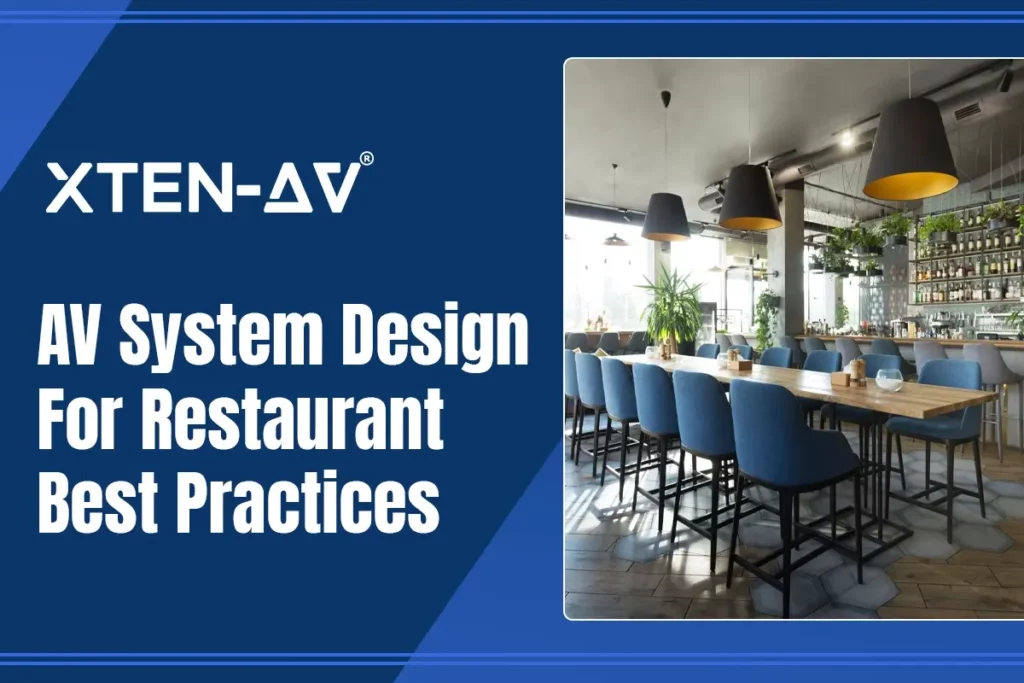Best Practices for Restaurant AV System Design To Deliver Great Dinning Experience
In an age where eating is about more than simply the food, audio visual aspects are essential. From mood-enhancing lighting to immersive soundtracks, restaurant AV design turns dining rooms into sensory experiences. However, it is more than simply aesthetics; it is about establishing an environment that improves consumer happiness and commercial success. Join us as we explore restaurant audio visual design, discussing the best practices for designing a restaurant’s AV system.
Understand The Restaurant Layout Thoroughly Before Designing The AV System.
Restaurant AV design requires familiarity with the restaurant’s layout and infrastructure. Observe the layout, seating configurations, and client-side footfall. Identify critical areas such as eating zones, bar counters, and outdoor areas. Peruse the infrastructure for accurate and possible placement of multiple AV equipment, such as speakers, displays, and control interfaces.
Moreover, the restaurant floor design, ambient lighting, noise, and physical architectural configurations affect audio visual function. Finally, this knowledge facilitates the development of a customized AV system design that harmoniously integrates into the restaurant’s floor plan and enhances client eating comfort while satisfying the restaurant’s operational and aesthetic demands.
Consider The Acoustics Of The Space To Ensure Optimal Sound Quality.
In AV restaurant design, restaurant acoustics are also essential for the immersive dining experience. The restaurant’s sound quality enhances the restaurant’s entertainment and keeps the customer actively involved. Through the food service plan, find out if the restaurant’s layout, materials, furniture, and interior might have potential sound problems, including echoing and noise amplification. Very carefully think about the specifications of the audio equipment, as well as the location of the speakers, to avoid such and ensure that audio spreads evenly throughout the restaurant.
Employ or recommend material that results in sound absorption to reduce echoing and enhance sound clarity. Consider the added loudness of kitchen activities and customer conversations when installing the AV system. By ensuring perfect audio acoustics in the restaurant’s audio visual design, you would have made a happy customer who would be willing to return.
Invest In High-Quality Audio And Video Components For Clear Sound And Crisp Visuals.
Equally crucial in restaurant AV design is including high-quality audio and video components. This and more should be done for corporate cafes, which should create a high-class, high-quality, and sophisticated dining environment. High-end restaurant audio visual systems ensure that sound reproduction is crisp and clear and that visual displays are high definition high-quality, improving the restaurant experience.
When choosing audio brands, make sure they sound clear from all areas, and the same goes for screens, which should have high resolution. Do a little research to ensure the best compatibility with the audio visual systems in your restaurant. Audio should have a clear sound in the restaurant and should allow you to play dynamic background music or announcements. Likewise, choose a beautiful video view that enables you to see the menu well and read the promotional content properly.
Divide The Restaurant into Zones and Implement Separate Audio Systems for Each.
Another technique that can be used in restaurant AV design is the division of the establishment into zones with their audio systems. The restaurant’s space can be divided into several areas, such as dining sections, bar areas, and outdoor seating, for which AV designers can create audio experiences that are distinctly separate from each other. The first use of restaurant AV technology to take advantage of separate audio systems is installing dedicated systems in each zone.
That means that the volume, type of content, and, in many cases, the overall level of ambiance can be adjusted by separate staff or managers. This can allow patrons to enjoy background music at a level that can be heard but doesn’t disturb conversations or dining experiences. When used correctly, the separate audio system can also allow for separate promotions or announcements that target specific groups of customers in the bar or the outdoor seating area.
Align The AV System with the Restaurant's Ambiance and Theme for A Cohesive Experience.
In the restaurant AV design realm, it is vital to ensure that the AV system blends with the ambiance and theme of the facility to realize an immersive and responsive environment. This is particularly true for in-and-out settings such as digital cafeterias and corporate cafes. Designers should incorporate audio visual systems for restaurants that align with the ambiance to enhance the environment and market the brand.
When picking the AV equipment and designing the layout, consider interior design elements, color schemes, and decor themes. Select audio visual elements that match the ambiance, whether it is a corporate cafe or a dynamic digital cafeteria.
Design Intuitive Control Interfaces For Easy Staff Operation.
It is crucial to integrate intuitive control interfaces to ensure that staff can efficiently operate the audio visual services, which will guarantee the restaurant’s seamless re-operation daily. Moreover, while designing AV system interfaces for the restaurant, there should be a focus on keeping the interfaces as simple and user-friendly as possible, enabling the staff to control the audio visuals easily. Opt for touch panels, mobile apps, or centralized control systems that the staff can use to turn the volume down, switch the content, or turn the lights off with limited training and technological knowledge.
In addition, ensure easily identifiable controls that make it simple to navigate and troubleshoot in a logical hierarchy. By incorporating intuitive interfaces into the restaurant’s audio visual design, you can create the level of efficiency and quality that minimizes mistakes and enhances employee happiness. It not only improves the dining familiarity for the customers but also aids in the operational excellence of the restaurant.
Ensure Robust Connectivity Throughout The Restaurant To Support Various Functions
Connectivity is essential to signal strength in restaurant AV design. Integration involves connecting various functions and services, from the audio visual components to digital signage and the online ordering system. Moreover, applied high-speed WI-FI and wired connections allow listeners and streamers to have uninterrupted access to published audio and video material and other online transactions for dinner.
Additionally, connectivity supports interactivity for the customer to view the digital menu and response-related features. Finally, connectivity supports regular system updates since one can monitor and analyze from a distance, quickly detecting the system’s normalcy and updating it to support its normal functioning.
Position Displays Strategically To Maximize Visibility Without Disruption.
Evidently, proper display positioning is critical in restaurant AV design to enable optimal viewing of the screens without interrupting the dining experience. The restaurant’s layout must be considered when deciding where the screens will be placed to ensure all people, including those in the restaurant’s interior design, have a clear line of sight to the screens without obstructing pathways or causing undue strain.
Use audio visual systems for restaurants that can be mounted on walls and ceilings or set up as freestanding digital signs to achieve desired positioning. More crucially, the screens must be integrated into the restaurant’s infrastructure in a way that suggests maximum compliance with the overall restaurant’s aesthetic to ensure a pleasant dining experience. Additionally, utilize your restaurant AV systems integration to enable you to synchronize all screens for improved consistency.
Build Redundancy And Scalability Into The AV System For Reliability And Future Expansion.
Redundancy and scalability are both critical elements that should be incorporated into the AV system of a restaurant to ensure reliability and facilitate future expansion. Redundancy involves utilizing backup components such as power supplies, servers, or failover mechanisms to lower downtimes in case an equipment failure occurs. Scalability, on the other hand, entails opting to install modular components or infrastructure that can be easily updated or expanded as a restaurant grows in size or as audio visual technology advances.
This could involve preparing extra zones, choosing additional bandwidth, or future-proofing against audio visual technologies that are still in the developmental stages. These measures result in a future-proof plan allowing restaurant owners to modify their AV system to continue serving patrons appropriately.
Establish A Maintenance Schedule And Support System For Ongoing Performance.
Restaurant AV design should include establishing a maintenance schedule and support system to maintain the audio visual system’s ongoing performance and reliability. Design a comprehensive AV maintenance plan that involves regular inspections, software updates, and equipment checks to catch and address problems before they can affect system performance. Design presentations for the staff or arrange an external service provider to help maintain routine maintenance and repairs and address technical issues when they occur.
In addition, AV designers should establish a robust support system to provide fast assistance to staff when they encounter problems or emergencies with AV. Design a helpdesk, train staff on basic troubleshooting procedures, and maintain clear lines of communication for reporting and addressing problems. By focusing on maintenance and support in restaurant AV design, establishments can limit downtime and optimize system performance.
Conclusion
Restaurants can create atmospheres that stay with clients long after the final bite by utilizing technology to stimulate the senses. Restaurant AV design can convert ordinary meals into unforgettable memories by utilizing inventive lighting, immersive audio, and interactive displays. So, as culinary landscapes shift, let us salute the ever-changing union of gastronomy and technology, which is creating the future of dining one sensory thrill at a time.
Frequently Asked Questions
Successful restaurant AV design encompasses various elements, including lighting, sound systems, and audio visual displays. These components work together to create an immersive dining experience that captivates customers. By carefully integrating these elements, restaurants can enhance ambiance, engage patrons, and differentiate themselves in a competitive market.
Restaurant AV design significantly influences customer satisfaction by shaping the overall dining experience. Well-executed AV design can create a welcoming atmosphere, set the mood, and enhance the enjoyment of meals. Immersive audio visual elements can elevate the dining experience, leaving a lasting impression on customers and increasing the likelihood of return visits and positive reviews.
Current trends in restaurant AV design include the use of LED lighting to customize ambiance, immersive audio systems for spatial sound experiences, and interactive displays to engage diners. Additionally, the integration of smart technology allows for seamless control of AV elements, enhancing convenience and flexibility for restaurant owners.
Investing in professional AV design services for restaurants offers numerous benefits, including expert guidance in selecting and integrating the most suitable audio visual elements for the dining space. Professional designers can enhance ambiance, improve customer engagement, and ultimately contribute to increased customer satisfaction and loyalty. Additionally, their expertise ensures seamless implementation and ongoing support, maximizing the return on investment for restaurant owners.

